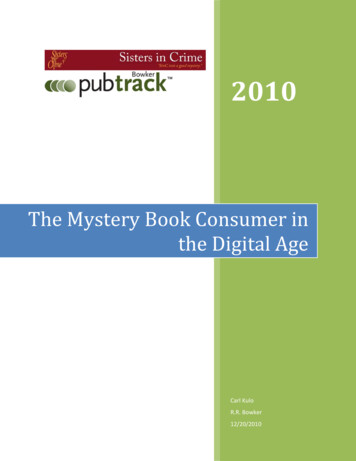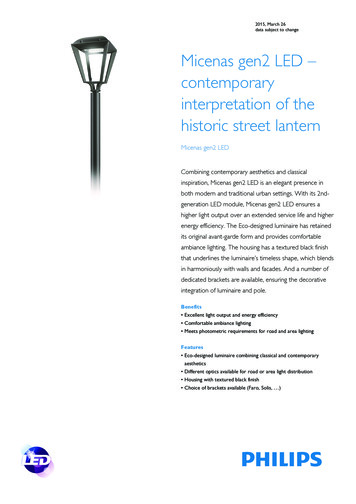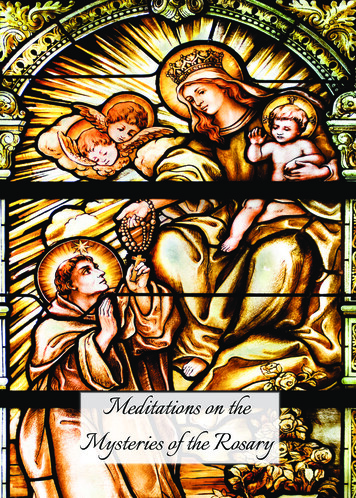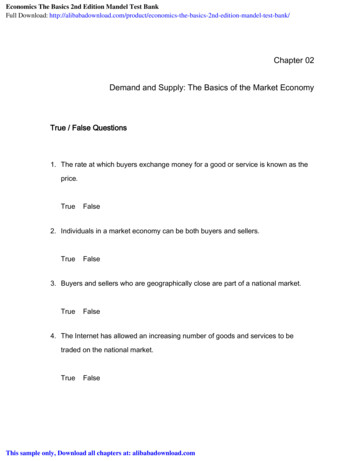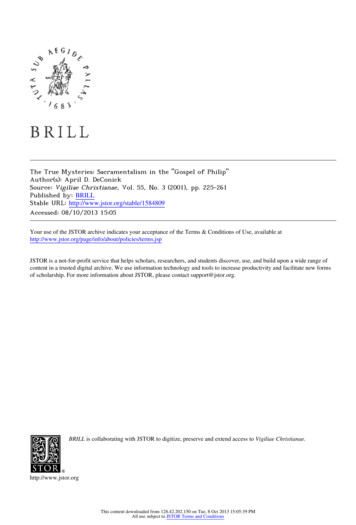
Transcription
The True Mysteries: Sacramentalism in the "Gospel of Philip"Author(s): April D. DeConickSource: Vigiliae Christianae, Vol. 55, No. 3 (2001), pp. 225-261Published by: BRILLStable URL: http://www.jstor.org/stable/1584809 .Accessed: 08/10/2013 15:05Your use of the JSTOR archive indicates your acceptance of the Terms & Conditions of Use, available at ms.jsp.JSTOR is a not-for-profit service that helps scholars, researchers, and students discover, use, and build upon a wide range ofcontent in a trusted digital archive. We use information technology and tools to increase productivity and facilitate new formsof scholarship. For more information about JSTOR, please contact support@jstor.org.BRILL is collaborating with JSTOR to digitize, preserve and extend access to Vigiliae Christianae.http://www.jstor.orgThis content downloaded from 128.42.202.150 on Tue, 8 Oct 2013 15:05:39 PMAll use subject to JSTOR Terms and Conditions
THE TRUE MYs'rERIESIN THE GOSPELOF PHILIP'SACRAMENTALISMBYAPRIL D. DECONICKPrevious scholars of Philip have identified the sacraments (which theyhave understood to be ritual activities) as a particularly troublesome puzzle. Thus ritual in Philip has been the subject of numerous important andintriguing academic studies over the last generation. Each of these studieshas helped steadily advance our understanding of the subject, clarifyingmany of the problems connected with interpreting the Gospelof Philip.2A roughdraftof this paperwas presentedin 1998 to the EarlyJewish and ChristianMysticismGroupat the annualmeetingof the Societyfor BiblicalLiterature.It appearedin draft form in the SBL SeminarPapers,Part 1 (Atlanta:ScholarsPress, 1998) 483-523under the title, "EnteringGod's Presence:Sacramentalismin the Gospel of Philip."Iwould especiallylike to thankmy respondents,Elaine Pagelsand CharlesGieschen,fortheir commentsand criticismson that draftas well as the membersof the EarlyJewishand ChristianMysticismGroup.In addition,my gratitudeis extendedto Gilles Quispeland Rachel Elior for readingearlierdraftsof this article and providingme with theirhelpfulcomments.2 Themajorworksinclude:H.M. Schencke,"'Das Evangeliumnach Philippus'.EinLiteraEvangeliumder Valentinianeraus dem Funde von Nag Hammadi",Theologische84 (1959) 1-26; E. Segelberg,"The Coptic-GnosticGospel accordingto Philipturzeitungand its SacramentalSystem",Jumen7 (1960) 189-200;idem,"The BaptismalRite accord5 (Berlin:ing to some of the Coptic-GnosticTexts of Nag-Hammadi",StudiaPatristicaAkademie-Verlag,1962) 117-128;R. Grant, "The Mysteryof Marriagein the Gospelof Philip," Vigiiae Christianae15 (1961) 129-140; H.-G. Gaffron, Studienzum koptischenunterbesonderer(Dissertation, RheinischeBericksichtigunder iversitatat Bonn, 1969);A.H.C. van Eijk, "The Gospel of Philipand Clement of Alexandria:Gnostic and EcclesiasticalTheology on the Resurrection25 (1971) 94-120; M.A. Williams, "Realizedand the Eucharist", VigiliacChristianae3 (1971) 1-17; idem,"Uses ofQuarteryEschatologyin the Gospel of Philip",RestorationGender Imagery in Ancient Gnostic Textes", in C. Walker Bynum, S. Harrell, andP. Richman (eds.) Genderand Religion On the Complexityof Symbols(Boston: Beacon Press,1986) 196-227;J.-M. Sevrin, "Les Noces Spirituellesdans l'lvangile selon Philippe",Le Musion87 (1974) 143-193; idem,"Les Rites et la Gnose, d'apres quelquesTexteset es",in J. Ries (ed.), GnosticismeUniversite Catholique de Louvain Institut Orientaliste,1982) 440-450; J.E. Menard,"'L'Evangileselon Philippe'et 'L'Exegesede l'Ame"',J.E. Menard (ed.) Les Tixtesde? KoninklijkeBrill NV, Leiden, 200155, 225-261rigiliaeChristianaeThis content downloaded from 128.42.202.150 on Tue, 8 Oct 2013 15:05:39 PMAll use subject to JSTOR Terms and Conditions
226APRIL D. DECONICKYet, despite this extraordinary effort, several issues need more discussion since we have yet to come to a consensus on the number of sacraments in Philip let alone a "sacramental theology." Given this situation,some scholars suggest that the style of Philip is so allusive that we can notunderstand the individual actions of the specific sacraments.3 This line ofreasoning is supported in the recent article by E. Pagels, "Ritual in theGospelof Philip",in TheNag HammadiLibraryAfterFiftyYears,and is furtherevidence that scholars are still struggling to reconstruct the ritual activityalluded to in this enigmatic gospel.4 In face of this impasse, I propose thatthe ritual activity in Philip and its sacramental theology can be reconstructedby seeing these traditions as reflective of similar traditions developing simul-NagHammadi(Leiden:EJ. Brill, 1975)56-67;JJ. Buckley,"A Cult-Mysteryin the Gospelof Philip", Journal of Biblical Literature99 (1980) 569-581; idem, "'The Holy Spirit is aDouble Name': Holy Spirit,Mary, and Sophia in the Gospelof Philip",in K. King (ed.),Images of the Femininein Gnosticism(Philadelphia: Fortress Press, 1988) 211-227; idem,"ConceptualModels and PolemicalIssues in the Gospel of Philip",in W. Haase andH. Temporini (eds.), Aufstiegund ]rVedergangder RimischenWelt II, 25.5, 4186-4190; D.H.Tripp, "The 'SacramentalSystem'of the Gospel of Philip",in E.A. Livingstone(ed.),StudiaPatristica17, part 1 (Oxford:Pergamon,1982) 251-260; K. Rudolph, "Responseto 'The Holy Spirit is a Double Name': Holy Spirit,Mary, and Sophia in the 'Gospelof Philip'byJorunnJacobsen Buckley", in K. King (ed.), Imagesof theFemininein GnosticismFortressPress, 1988) 228-238; E. Pagels,"Adamand Eve, Christand the(Philadelphia:Church:A Surveyof Second CenturyControversiesConcerningMarriage,"in A.H.B.Logan and AJ.M. Wedderburn (eds.), The New Testamentand Gnosis:Essays in HonourofRobertMcL. Wilson(Edinburgh:T.&T. Clarke, 1983) 146-175; idem,"The 'MysteryofMarriage' in the Gospelof PhilipRevisited", in B.A. Pearson, TheFutureof Early Christianity:Essays in Honorof HelmutKoester(Minneapolis: Fortress Press, 1991) 442-454; idem,"Ritualin the Gospelof Philip",in J.D. Turner and A. McGuire (eds.), The Nag HammadiLibraryNHMS 44afterFifty rears, Proceedingsof the 1995 Sociey of BiblicalLiteratureCommemoration,(Leiden:EJ. Brill, 1997) 280-291; M.A. McPhersonOliver, "The Gospelof PhilipandEarly ConjugalChristianity",paper deliveredat Nag Hammadi Seminar, HaverfordCollege, November 17, 1995;J. Buckleyand DJ. Good, "SacramentalLanguageandVerbs of Generating,Creatingand Begettingin the Gospel of Philip,"Journalof EarlyChristianStudies5 (1997) 1-19.Summariesof ritualactivityin Philipalso can be found in the severalcommentarieson thisgospel:R. McL.Wilson,TheGospelof Phip (NewYorkand Evanston:Harper&Row,1962); J.-E. Minard, traduction,commentaireLetouzy& Ane, 1967);W.W. Isenberg,"The CopticGospelAccordingto Philip"(Ph.D.diss., Universityof Chicago, 1968); "Introduction",in B. Layton (ed.), Nag HammadiCodex11,2-7 togetherwith XIII,2*, Brit. Lib. Or.4926(1), and P.Oxy. 1, 654, 655, Nag HammadiStudies20, v. 1 (Leiden:EJ. Brill, 1989) 131-139;H.-M. Schenke,Gospelof Philip.German& Coptic.Das Philippus-Evangelium(Nag-Hammadi-Codex11,3) (Berlin: Akademie Verlag,1997).3 See rin,"LesNoces Spirituelles",143-193.4 Pagels, "Ritualin the Gospelof Philip",280-291.This content downloaded from 128.42.202.150 on Tue, 8 Oct 2013 15:05:39 PMAll use subject to JSTOR Terms and Conditions
THE TRUE MYSTERIES227taneously in early Jewish mystical circles, circles which were advocatingmystical ascent through the heavenly Temple and a transformingvision ofGod.5According to the pioneering research of R. Elior, in the aftermath ofthe destruction of the Temple in 70 C.E., Jews within these mystical circles were perpetuating Temple worship by fostering the idea of a surrogate heavenly Temple. This idea was developed largely from the visionsof Ezekielwhich were preservedfollowingthe destructionof the firstTemple.Refusing to accept the end of their religious worship in the wake of thedestruction of their cult center, they focused on the notion of a spiritualworld whose cultic practices now operated on a mystical-ritualpraxis. Thestructureof the earthly Temple was projected into the heavens as a seriesof three or seven hekhalotor shrines, merkavotor chariots, devirimor Holy ofHolies.6 The priestly and levitical traditions of Temple worship were elevated and transferredto these supernalregions in the form of angelic dutiesand liturgicalpractices. The priestly ritual was understood to be performedby the angels in the heavenly sanctuary.As the primaryliturgicalperformers,the angels were responsible for the ceremonies associated with the priestlyblessing, the use of Divine Names, the pronunication of the unutterableName of God, the recitation of prayers, and the performance of music.7The Jewish mystic could now ascend through the various hekhalotorshrines in order to journey to the inner sanctum and worship before God's5 EarlyJewish mysticismis an esoterictendencywithinSecondTempleJudaismwhichwas characterizedby speculationabout ascendinginto heaven and gaining a transforming vision of the manifestationof God. Evidence for this tendency can be seenmainly in the Philonic corpus,Jewish apocalypticliterature,the Qumran manuscripts,and the Hekhalot texts. For a fuller discussion,refer to A.D. De Conick, Seekto Seeto Vigliae Christianae33HimuAscentand VisionMysticismin the Gospelof Thomas,Supplements(Leiden: EJ. Brill, 1996) 28-37; idem, Voicesof the Mystics:Earlv ChristianDiscoursein theGospelsof John and Thomas and otherAncient ChristianLiterature,JSNTS 157 (Sheffield:SheffieldAcademicPress, 2001) especially47-61.6 Cf. the threeheavens,see C.R.A. Morray-Jones,"ParadiseRevisited(2 Cor 12:112):The Jewish MysticalBackgroundof Paul'sApostolate.Part 1: The Jewish Sources",Review86 (1993) 203-205. These are replacedby a seven-tiersystem.HarvardTheologicalOn this, referto A.Y. Collins,"The Seven HeavensinJewishand ChristianApocalypses,"in JJ. Collins and M. Fishbane (eds.), Death, Ecstasyand OtherWorldyJourneys(Albany:State Universityof New York Press, 1995) 62-87.7 See R. Elior, "FromEarthlyTemple to HeavenlyShrines:Prayerand SacredSongin the HekhalotLiteratureand its Relationto Temple Traditions",JewishStudiesQuartery4 (1997) 217-267. Cf.J. Maier, VomKultuszurGnosis(Salzburg:Mueller, 1964) 133-135;C. Newsom, Songsof theSabbathSacrfice(Atlanta,1985);iden, "'He Has EstablishedforHimself Priests"', in L. Schiffman (ed.), Archaeologyand History in the Dead Sea Scrolls(Sheffield:JSOT Press, 1990) 114-115.This content downloaded from 128.42.202.150 on Tue, 8 Oct 2013 15:05:39 PMAll use subject to JSTOR Terms and Conditions
228APRIL D. DECONICKthrone.8 He could enter the devir, the Holy of Holies, and gaze on God'smanifestation enthroned upon the merkavah,the seat consisting of two cherubim with wings spread over the kapporet,the lid of the Ark of the Covenant(1 Chron 28:183; cf. 1 Kings 6:23-28, 8:6-7; 2 Chron 3:10-1, 5:7-8). Forthe human practitioner, this journey was understood to be a transformative experience. This transformation generally was described in terms ofthe human's transfiguration into an angel, his participation in the heavenly liturgy, or his own enthronement.9 Often the transfiguration involvedthe revelation of secret knowledge about the world's operation.0lIn the Gospelof Philip, we are faced with a series of three Temple shrinesrather than seven: the Holy shrine, the Holy of the Holy shrine, and theHoly of the Holies shrine:There are three shrines (HCIl)"for sacrificeinJerusalem. The one opening tothe west was called "the holy" (neTOY&&1B).Another opening to the southwas called "the holy of the holy" (neTOy&&a6nJ1eToy&& ). The third open-8 Thegeneralconcept of ascent has been the subjectof severalworks:W. Bousset,"Die Himmelsreiseder Seele", Archiv4 Freiburg:J.C.B. Mohr,fr ReligionswissenschaftBook,1901) 136-169, 229-273; G. Widengren,TheAscensionof theApostleandtheHeavenlyUppsala UniversitetsArsskrift7 (Uppsala:Lundequistskabokhandeln,1950);C. Colpe,"Die 'Himmelsreiseder Seele' ausserhalbund innerhalbder Gnosis,"in U. Bianchidi Messina13-18 Aprile1966, NumenSupplements(ed.), Le OriginidelloGnosticimo,Colloquio12; (Leiden:EJ. Brill, 1967)429-447;A. Segal, "HeavenlyAscentin HellenisticJudaism,derRomischenWeltEarly Christianity,and their Environment",AufstiegundNiedergang2.23.2 (Berlinand New York: De Gruyter, 1980) 1333-1394; U. Mann, "Geisthoheund Seelentiefe:Die vertikaleAchse der numinosenBereiche",Eranos50 (1981) 1-50;M. Smith, "Ascentto the Heavensand the Beginningof Christianity",Eranos50 (1981)403-429; I.P. Culianu,"L' 'Ascensiondel'ame' dans les mystereset hors des mysteres,"in U. Bianchiand MJ. Vermaseren(eds.),La erningI: A Survgy(Leiden:EJ. Brill, 1982) 276-302; idem,Psychanodiaof theEvidencetheAscensiondel'Extaseof theSoulandIts Relevance(Leiden:EJ. Brill, 1983);idem,Experiences(Paris:Payot, 1984);M. Dean-Otting,HeavenlyJournys:A Studyof theMotifin Hellenisticam Main:P. Lang, 1984);J.D. Tabor, Ascentto Paradisein its am:UniversityPressof America,1986);M. ypses(Oxford:Oxford UniversityPress, 1993).9 For the idea of transformation,see C. Morray-Jones,"TransformationalMysticismin the Apocalyptic-MerkavahTradition",Jounalfor JewishStudies48 (1992) 1-31. For adiscussionof participationin angelicliturgy,see Elior, "FromEarthlyground-breakingTemple to HeavenlyShrines".Refer also to the earlierwork by Himmelfarb,AscenttoHeaven,29-71. For the theme of enthronement,see E. Wolfson,"Yeridahla-Merkavah:Typology of Ecstasyand Enthronementin AncientJewish Mysticism,in R.A. Herrera(ed.), Mysticsof theBook 7Themes,Topicsand Typologies(New York:Peter Lang) 13-45.'0 I. Gruenwald,"Knowledgeand Vision: Towardsa Clarificationof Two 'Gnostic'Studies3 (1973) 63-107.Conceptsin the Light of Their Alleged Origins",IsraelOriental" I translateHEI as "shrine"becausethis translationcapturesits meaningwithin thisThis content downloaded from 128.42.202.150 on Tue, 8 Oct 2013 15:05:39 PMAll use subject to JSTOR Terms and Conditions
THE TRUE MYSTERIES229ing to the eastwas called"theholy of the holies"(neToy&aa HRiTOy&a),the place whereonly the high priestenters(69:15-21).Philipassociatesthese shrines with particular"sacraments:""Baptismis 'theholy' shrine. Redemption is 'holy of the holy'. 'The holy of the holies' isthe bridal chamber" (nJIBnJTCA& ne niRHEJ?TOYba& [rn]cc[T]e nrTOYy .AneTOy B n?TeT[0Yoy&]&inlCTOY&aM n e nY ApCi)(69:22-25).12Also in 67:28-30 we find a passage which identifies the "sacraments"as baptism, chrism, eucharist, redemption, and bridal chamber: "The Lord[did] everything in a mystery: a baptism and a chrism, a eucharist and aredemption, and a bridal chamber" (ru2soet [C p] ,0ofiMNA9HnOyAYAR oYXPIC & ARNoyeyYXPo[iCT].CTHplfO oysa&[n]TICA.AtNOyCC(OT ANHOyNyAqyp0N).'3Clearly baptism, chrism, and the eucharist are ritual activities.But whatabout "redemption"and "bridalchamber?"Does AYCTHplOl, or "sacrament," have to indicate a ritualsacrament as Segelberg and others afterhim have assumed? Or can it be more inclusive, describing an experiencein which the human does not participate alone, but where he acts in communion with God? In a "sacrament,"the human participatesin a higherreality, the reality of the Spirit without ever ceasing to be human. Longago, the Church Father John Chrysostom explained that a "sacrament"had a double meaning: "what we believe is not the same as what we see,but we see one thing and believe another."'4The distinctive feature of asacrament is that it is at once both "visible and invisible."'5It is a combination of "an outward visible sign with an inward spiritualgrace."16Theycontext better than "building"as W.W. Isenbergrendersin the criticaledition editedCodes11,2-7 togetherwithXIII,2* Brit.Lib. Or. 4926(1), andby B. Layton,Nag HamnmadiP. Oxy. 1, 654, 655, Nag HammadiStudies20, v. 1 (Leiden:EJ. Brill, 1989) 180-181.The Coptic Hel is associatedwith oalcvi (templeor house),olico; (templeor house ofgod), oicilxa (chamber,temple, or chapel), lAxoX;(the innermostroom), and Sitxita(room).On this refer to Crum, 66a. Cf. R. Cameron, "AncientMyths and ModemTheoriesof the Gospel of Thomas and ChristianOrigins,"MethodandTheoryin theStudyof Relgion11 (1999) p. 242.12Layton,Nag HammadiCodex11,2-7, 180.13 Punctuationis my own. For text and translation,seeLayton and Isenberg,NagHammadiCodex11,2-7,176-177.In this passage,I understandswte to referto the redeeming power of the rituals,availablethroughparticipationin the Eucharistin particular,and realizedor actualizedin the eschatologicalBridalChamber.Thus it is not a separate ritual.Other passagesin Phip seem to supportthis interpretation:62:14, 69:23;69:26; cf. 53:2; 53:14; 71:2-3; 85:29.14 Homilieson 1 Corinthians,7.1 (P.G.61.55).New Edition(New York:Penguin, 1993) 274.'5 T. Ware, The OrthodoxChurch:16Ware, Orthodox,274.This content downloaded from 128.42.202.150 on Tue, 8 Oct 2013 15:05:39 PMAll use subject to JSTOR Terms and Conditions
230APRIL D. DECONICKare the means by which "God's grace is approriated to every Christianindividually."'7Today, according to Meyendorff, "a sacrament is a 'passage'to true life; it is man's [humanity's!]salvation."'8A sacrament is an "eternal Mystery where the boundaries between heaven and earth are brokenand where human decision and action acquire an eternal dimension."'9If we allow for this broader definition of AYCTlHplOnin Philip, then"redemption"and the "bridal chamber" might not be actual rituals, butinstead holy "mysteries"which, in some way, allow the human to connectto the divine source of life. Therefore, the sacraments should be understood to include manners of thinking sacrally, mundane activities infusedwith sacrosanctmeanings, as well as ritual performances.Philip'ssacramentsseem to have this double entrendre: a worldly meaning which is "deceptive" and an eternal meaning which is "correct"(53:24-35). Thus, I contend that it is necessary to let AYCTHPIONfunction in this broader senserather than the narrowly confined understandingthat has permeated previous scholarship.If we allow for this broader definition, I believe that thecomplicated passages which refer to baptism, chrism, eucharist, redemption, bridal chamber, and marriage in Philipbecome much more sensible.In this paper, therefore, I propose a new paradigm for interpretingthesacraments in Philip, a paradigm grounded in the broader definition of"sacrament." So I understand "sacraments"or the "true mysteries" toinclude more than ritual activities;they also identify those human thoughtsand actions which have been invested with sacral meaning.In addition,I hope to demonstratethatjust as theJewish mysticsinventeda surrogate supernal Temple of seven shrines through which they couldascend to the Presence of God and perform their liturgicalduties, the Gospelof Philippreserves a similar celestial Temple tradition. Its three heavenlyTemple shrines represent the esoteric reality behind the sacraments. It isplausible that these sacramentsare understoodon the spirituallevel to represent the three rooms of the previously destroyed Temple: the ulam orvestibule; the hekhalor cental room; and the deviror inner sanctum. Justas each of these rooms represents a greater degree of holiness within theTemple,20so does each sacramentin Philip.Each stage in the ascent through17 Ware, Orthodox,276.18J. Meyendorff,Mariage:An OrthodoxPerspective(Crestwood:St. Vladimir'sSeminaryPress, 1984) 20.19Meyendorff,Marriage,23.20 M. endonPress,1978).TemplesThis content downloaded from 128.42.202.150 on Tue, 8 Oct 2013 15:05:39 PMAll use subject to JSTOR Terms and Conditions
THE TRUE MYSTERIES231the rooms of the heavenly Temple brings the believer closer to the devir,the Holy of Holies where the Presence of God dwells, seated upon hisAs the believer moves through each Temple shrine, he is promerkavah.gressivelytransformed.For the Christian Gnostic, this ascent culminates inan eschatologicalexperience at the much-anticipatedEnd, when the believerfinally is able to enter the Holy of Holies and gaze upon the Father, fullytransformed.Rituals1) The InitiatorySacramentalThe initiatory stage in the mystical-sacramentalpraxis is a ritual performance stage. Since this stage is the first of the three Holy shrines, itplausibly can be associated with the ulam or vestibule of the Temple inJerusalem. It is quite noteworthy that before the priests were permitted toenter the Temple, they had to ritually immerse themselves (cf. Mishnah,Tamid1:2, 4; 2:1; cf. roma 3:3). This immersion took place in the "sea ofbronze" (1 Kg 7:23-26), a great water container supported by twelve statues of bulls (2 Chron 4:6). This basin was located to the south of the altarThis aspect is transferredto the angels in the Hekhalotjust outside the ulam.21literaturewhere they too must bath and purify themselves in order to carryout their liturgical functions in the heavenly Temple.22In Philip,the two initiatory rituals are performed at the same time: baptism by water and baptism by fire, which is unction or chrism (cf. 57:2329; 67:3-9; 69:5-15). These rituals are performed for purificationpurposes.Baptism by water and fire operate on two levels, purifying the "visible"orphysical aspect and the "hidden" or spiritual aspect: "It is through waterand fire that the whole place is purified-the visible by visible, the hidden by hidden" (9JTR oyAOOY AM OYMKOtTCYTOYBOAIT.A THp4H NECeHI 2NHCTOYOntg,9ITR NrTOYOnri C?BfiOeHrn) (57:23-25).Philipexplains that the water and oil work to consecrate the soul and thespirit:"It is from water and fire that the soul and spiritcame into being. thefire is the chrism" (eCBONo, OYAOOYAN OYKO)2TNT& TIryX[H] AN21R. de Vaux, AncientIsrael- Its Life and Institutions(translated by J. McHugh; NewBookCompany,Inc., 1961)319-320;H. anslatedby D. Green;London:S.P.C.K.,1966)161;FJ. , 1991) 77.22 Cf. P. Shafer,zur Hekhalot-Literatur(Tubingen, 1981) paragraphs54, 181,Synopsereferto Elior,"FromEarthlyTempleto184-185,811, 814-816,916. For discussion,HeavenlyShrines".This content downloaded from 128.42.202.150 on Tue, 8 Oct 2013 15:05:39 PMAll use subject to JSTOR Terms and Conditions
232APRIL D. DECONICKInnnT {ionC . *nKfO T nI nrXpICAo)(67.3-6). The hidden quality ofthe oil is that it is the holy fire of the sacred realm "whose form is white,which is bright and beautiful, and which gives beauty" (nKCeoY eCT TrC Aop(pHoY&BgI ETO noyoClMCHncCoaYoy eCTtfiTAH TC6,)(67:7-9).I suggest that the hidden quality of the oil functions to consecrate theperson so that he may enter the fiery realm of heaven. It is a well-documented part of heavenly geography that a river of fire flows near thethrone of the Glory.23The angels in Jewish texts purify themselves in theriver of fire in order to prepare themselves to join in the heavenly Templeliturgy (3 Enoch36; Schafer, section 920). It appears that this heavenlygeography was embedded deeply in the Valentinian traditionsince it showsas well. In this text, there is a river of fireup in the Extractsof Theodotus2that runs beneath the throne. Moreover, the whole space of the Holy ofHolies is fire. The veil conceals the fiery depths of the Holy of Holies fromview so that no one is "destroyedby the sight of it" (At&aToo. ). Only the archangel,&vaXco&fithe High Priest, enters the Holy of Holies. This is Jesus who was calledin and enthroned. He will provide passage for the saved seed into thePleroma only at the End (38:1-3).The connection between the initiatory rituals and immersion in the fireof heaven may have developed in response to the fact that some traditionsrememberedJesus' own baptism as an event bringing with it heavenly fire.Justin Martyr, for instance, tells Trypho that the Jordan River was blazing with fire when Jesus entered the water (tivp avipGrl ?v TX 'Iop8avn).When he came out of the water, he received the Holy Spirit (DialoguewithTrypho88).25In two old Latin recensions of Matthew 3:15, there is mention that a great light shone out of the water at the moment of Jesus'lumeningenscircumfulsitde aqua;Vgm":et cumbaptism (Ita:et cumbaptizaretur,Iesus, lumenmagnumfulgebat de aqua). According to Ephrem'sbaptizareturon theDiatessaronCommentary4.5, there was "the shining of the light uponthe waters". The combined evidence has caused W.L. Petersen to con-23 For acompletelist of references,refer to H. Odeberg,3 Enochor the ss, 1928) 60 n. 19, 112 n. 4.24 For critical edition, see F.Sagnard, Les Extrais de Thiodote,SourcesChriitiennes23(Paris:Les tditions du Cerf, 1948).25 Epiphaniusrecordsthat after the voicespoke from heaven, "immediatelya great30.13.7.light shone aroundthe place" (Evfi;S epitXagyeTovtoxov (pxs; Cya)PanarionThis content downloaded from 128.42.202.150 on Tue, 8 Oct 2013 15:05:39 PMAll use subject to JSTOR Terms and Conditions
THE TRUE MYSTERIES233elude that this tradition is very old and was either forgotten or rejectedby later Christians.26In addition to their consecrating power, the initiatory rituals in Philipare understood to be a new birth for the believer, begetting him "throughChrist in the two [i.e., baptism and chrism]" (2,ITH neXC 2A nCn&y)(69:5-7; cf. 67:13-20). This emphasis on rebirth is also highlighted in theValentinian Extractsof Theodotus78:1-2 where baptism liberates one fromFate, bringing about rebirth. This rebirth probably mirrors the spiritualbirth of the aeon Jesus who had been conceived through the union of theVirgin or Holy Spirit and the Father in the Pleromic bridal chamber(Gos.Phil.55:24-29; 71:4-11), since the text indicates that "we are indeedreborn through the Holy Spirit" (CfiBOlIT* nRi& CTOy&& Cc 2n110Actn -Ao[n] HKecon) (69:5).27Because the text understandsbaptism to be regenerative (cp. John 3:3),it should not be surprising that it takes issue with the Pauline theologythat through baptism the believersundergo ritual death: "Do you not knowthat all of us who have been baptized into ChristJesus were baptized intohis death (i a&yvoeieiot, iaowEpaMxRia0ev cis Xptoaxv 'ITlooiv, eiS xovOavaxrov XDotioepacti*roLev)?Therefore we have been buried with himouv autrr 68iaTxo pacxTioLatxo;by baptism into death (ouvecapajlcevei; 'bva6vaxov)"(Rom 6:3-4a).28In response, Philip explains that "by perfectingthe water of baptism, Jesus emptied it of death. Thus we go down intothe water, but we do not go down into death" (iHe RT& ic 20oKtfi0eeAIrAOOy AnaiJI&TICA&Tnco?TC?o0NAAOY CeTBnH&eT&Il TT ECTIfBHKAMenCnTifTi CIOOY THBHK25? &H CntITHCHnAOY)(77:8-11).Rather, through the baptismal ceremonies, which included anointing withholy oil, the initiate is reborn of the Holy Spirit and then is invested withthis Spirit (64:23-27).29Furthermore, the investment of the Holy Spirit through the initiatoryrituals is connected to the investment with the redeeming Name of God.Indeed, in Philip the initiate not only gains the name of Christ through26W.L.Petersen,Tatian'sDiatessaron:Its larship(Leiden:EJ. Brill, 1994)20. Cf. B.H. Ehrman,7he ordUniversity27 Concerningthisnotion,see now Pagels,"Ritualin the Gospel285-286.of Philip",28 Cf. Pagels,"Ritualin the Gospel286-287.of Philip",29 On the connectionin earlyChristianitybetweenunctionandthe receptionof theBeforeGod:A NewInterpretationof LogionHolySpirit,seeA.D.De Conick,"Stripped37 in the Gospel of Thomas", VigiliaeChristianae45 (1991) 125-127.This content downloaded from 128.42.202.150 on Tue, 8 Oct 2013 15:05:39 PMAll use subject to JSTOR Terms and Conditions
234APRIL D. DECONICKchrism (74:12-25), becoming a "Christian",but he now is transformedinto"a Christ" (oYXpC ne) (67:29). The name of Christ, of course, is the unutterable Name of the Father which he gave to Jesus (oyp&r{ OyOTA JIKOCAOCHnpn&NRT ReicoT T&ay AHnwHpc)A&YTCYOyy(54:6-10). Moreover, as Philip indicates, Jesus "clothed himself with theso that he wouldName of the Father" (&qft i1(txoq Aflp&H AnIIT)be transformedinto the Father (54:10-11). The Christianswho have beeninvested with this Name, know the Name but do not speak it (54:11-12).It is "the Name above all things: the name of the Father"(qf2occ coyonrilA TCenH&een npn&H nIlCOT) (54:7). Obviously, it is the same asreferred to in Philippians 2:9, To ovogoaTo inEpnav ovoga, which is givento Jesus: icKpto;the Greek substitute for the Tetragrammaton.30The investitureof the Valentinian Christian with the unutterableNameof God may have been in imitation of Jesus' own baptism and investiturewith the Name since the Valentinians taught that the descent of the spiritor dove (cf. Mark 1:10) is associated with the investiture of the Name ofGod (cf. Extractsof Theodotus22:5-6).31Thus, through the initiatory rituals,the believer imitatesJesus' investment with the Name at his own baptismin the Jordan.Irenaeus alludes to this connection in his statement about the investment of the Name upon the Valentinians: "the Name which is hidden (r6from every deity, dominion, and power, whichovoga TOaloKcEcp'vuggvov)Nazarenedonnedthe(o eve6oaxro)in the spheres of light, [the Name]Jesusof Christ" (Adv.haer.1.21.3). Notice, according to Irenaeus, that Jesus putson the Name in the "spheresof light". This must denote investiturewithinthe heavenly realm perhaps representingthe supernalhidden reality behindJesus' external baptism.Such an allusion makes me speculate whetherJesus' investitureand tha
Gospel of Philip", in The Nag Hammadi Library After Fifty Years, and is further . evidence that scholars are still struggling to reconstruct the ritual activity alluded to in this enigmatic gospel.4 In face of this impasse, I propose that the ritual activity in Philip
